Here's what I did:
1. Remove the shoulder pads. Always the first step when taking the ugly out of old dresses.
2. Rip out the seams along the shoulders and sleeves, removing the neck ties and the sleeves completely.
3. Re-sew the shoulders, following the original seams lines.
4. Take the dress in on the sides to make the arm holes smaller and the dress more fitted. I wanted the dress to be more of a shift style, so I only took in the sides about 6" down from the arm holes. If you want a more fitted dress, you would take it in all the way down to the hem.
5. Reshape the arm holes. I used a dress that fits well to see how much to trim from the arm holes. This was probably one of the more difficult steps, but you can see in the picture above the chalk line around the arm hole, that is where I cut to make the hole smaller.
6. Take in sleeves. The sleeves on this dress were enormous and the cuffs were very tight fitting around my wrists so I knew I would have to do a lot of work to make them look normal. Again using a finished dress for reference I determined the new length for my sleeves and cut the bottom 5" off each sleeve, then took each sleeve in another 4" (2" from each side of fabric, where the pins are).
7. Make the cuffs. I used the fabric I cut off of the bottom of each sleeve to make the cuffs. After determining how big I wanted them, I cut them to size and then ironed on a very lightweight interfacing to the wrong side of the fabric to give the cuffs some shape. I then sewed them into a circle, with right sides together, pressed the seam open and then folded down each raw edge about 1/2".
8. Attach cuffs to sleeves. First I basted along the bottom edge of the sleeve, then pulled the basting stitch gently to pucker the sleeve. Only pucker the sleeve enough to make the opening the same size as the cuff (you want a slight pucker, but don't want to go back to what the dress looked like originally). Next, I pinned the open cuff to the inside of the sleeve (the sleeve is right side out for this step), sewed it on, then folded the cuff over and topstitched.
9. Attach the sleeves. Sewing on sleeves is always a little hard hard for me, but especially when I am doing alterations because my sleeve and my arm hole often end up not matching as well as they would from a pattern. Getting the sleeves on took a little bit of time because I had to do several adjustments as I went. It's always a good idea to use a basting stitch first when attaching your sleeves and then go over it with a regular stitch once the sleeve is in place and has no puckers. Rather than give you my step-by-step here, I'll share the best tutorial I have ever seen on attaching sleeves: Teach Yourself to Sew: How to Sew A Sleeve
10. Make sash. I used the remnants of the neck tie to make a sash for my waist. First, turn the neck ties wrong side out. Following the straight seam on each half of the neck tie, I continued sewing to the end of the fabric and then cut off the excess. Then I turned each strip right side out and ironed them flat. I folded the end of one strip inside itself, then tucked the raw edge of the other strip into it and topstitched it in place.
11. The picture doesn't show it, but a good tip to make projects look professional is to always give them a good iron when they are done. And, you're finished!

























